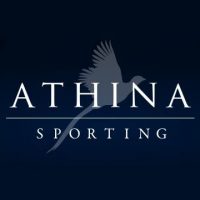
www.AthinaSporting.Com
Email: Info@AthinaSporting.com
quote:Nilgai*
Order Artiodactyla : Family Bovidae : Boselaphus tragocamelus (Pallas)
Description. A large antelope with short, smooth horns in males. Horns average only 18 cm in length, with lengths of only 23-30 cm the maximum. Females usually do not grow horns, but may occasionally.
Nilgai stand 119-150 cm at the shoulder, with prominent withers giving them a backline that slopes to the rump. In bulls, powerful shoulders and a thick neck tend to accentuate this sloping profile.
Overall coloration is gray to brownish gray in males; females and young are brown to orangish brown. Patches of white on the face and below the chin, extending into a broad, white "bib" on the throat, break up the ground coloration. A narrow white band along the brisket area broadens over the abdomen and spreads between the hind legs to form a narrow rump patch that is edged with darker hair. Below the white bib hangs a tuft of hair, or "beard," which may be as long as 13 cm in males.
Bulls weigh 109-288 kg, with the maximum about 306 kg. Females weigh 109-213 kg.
Distribution in Texas. Nilgai are native to India and Pakistan, where they are the largest species of antelope. Nilgai were imported into Texas as game animals and have readily reproduced and established free-ranging populations. They are the most abundant free-ranging exotic ungulate in Texas and have done especially well in South Texas. The majority of Texas nilgai are found in free-ranging populations on several large ranches in Kenedy and Willacy counties.
Habits. Avoiding densely wooded areas, nilgai inhabit relatively dry areas of flat to rolling country with a moderate cover of thin forest or scrub. The South Texas brush country is ideally suited to these animals.
Forage preference is based primarily on availability. Nilgai both graze and browse, with grasses constituting the bulk of the diet. In Texas, mesquite, oak, partridge pea, croton, nightshade, and a variety of grasses are eaten.
Nilgai typically herd in small groups of about 10 animals although larger groups of 20-70 are occasionally seen. Males and females remain segregated for most of the year, with bulls joining the cow-calf groups only for breeding. In Texas, most mating activity occurs from December through March; however, breeding can occur throughout the year. The period of gestation is 240-258 days and nilgai commonly bear twins. In favorable conditions females only 18 months of age can conceive, but few females mate before 3 years of age. Males become sexually mature by 2½ years of age but usually cannot compete successfully with other males until about 4 years old.
In South Texas the life expectancy of nilgai is about 10 years, providing they survive the most vulnerable period — from birth to about 3 years of age, when adult proportions are attained. In Texas, coyotes are the primary predator of nilgai calves but are not of sufficient size to take full grown animals. In addition to people and coyotes, cold weather can cause significant mortality among nilgai in South Texas. Nilgai have a thin coat and store only a meager winter fat reserve. Although rare in South Texas, prolonged periods of cold temperatures will dramatically reduce nilgai populations. During the severe winter of 1972-73, 1,400 of 3,300 nilgai were killed by the weather in South Texas. This die-off was exacerbated by previous brush clearing, which resulted in forage loss and increased competition with livestock and other wildlife.

